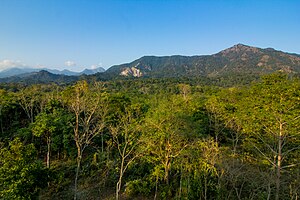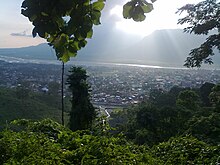| This article needs additional citations for verification. Please help improve this article by adding citations to reliable sources. Unsourced material may be challenged and removed. Find sources: "Alipurduar district" – news · newspapers · books · scholar · JSTOR (January 2021) (Learn how and when to remove this message) |
| Alipurduar Ālipurduār Jelā (Bengali) | |
|---|---|
| District | |
     Clockwise from top-left: Evening at Jaldapara National Park, ruins of Buxa Fort, Hut used by Toto aboriginals, Jayanti Hills in Buxa Tiger Reserve, Bhutan gate near Jaigaon
Clockwise from top-left: Evening at Jaldapara National Park, ruins of Buxa Fort, Hut used by Toto aboriginals, Jayanti Hills in Buxa Tiger Reserve, Bhutan gate near Jaigaon | |
 Location of Alipurduar district in West Bengal Location of Alipurduar district in West Bengal | |
| Coordinates: 26°29′20″N 89°31′37″E / 26.489°N 89.527°E / 26.489; 89.527 | |
| Country | India |
| State | West Bengal |
| Division | Jalpaiguri |
| Headquarters | Alipurduar |
| Government | |
| • Subdivisions | Alipurduar Sadar |
| • CD Blocks | Madarihat-Birpara, Alipurduar I, Alipurduar II, Kalchini, Falakata, Kumargram |
| • Lok Sabha constituencies | Alipurduar |
| • Vidhan Sabha constituencies | Alipurduars, Kumargram, Falakata, Madarihat, Kalchini |
| • District Magistrate | Smt. R. Vimala, IAS |
| Area | |
| • Total | 3,383 km (1,306 sq mi) |
| Population | |
| • Total | 1,491,250 |
| • Density | 440/km (1,100/sq mi) |
| • Urban | 307,456 |
| Demographics | |
| • Literacy | 78.57 per cent |
| • Sex ratio | 949 ♂/♀ |
| Languages | |
| • Official | Bengali |
| • Additional official | English |
| Time zone | UTC+05:30 (IST) |
| Website | alipurduar |
Alipurduar district is the 20th district in the state of West Bengal, India. The district has its headquarters at Alipurduar. It was made a district by bifurcating Jalpaiguri district in 2014. The district consists of Alipurduar municipality, Falakata municipality and six community development blocks: Madarihat–Birpara, Alipurduar–I, Alipurduar–II, Falakata, Kalchini and Kumargram. The six blocks contain 66 gram panchayats and nine census towns.
Administration
Apart from the Alipurduar municipality and Falakata municipality, the district contains eight census towns and rural areas of 66 gram panchayats under six community development blocks: Madarihat-Birpara, Alipurduar-I, Alipurduar–II, Kalchini, Falakata and Kumargram. Geographically the district lies between 26.4°N to 26.83°N and 89°E to 89.9°E.
The nine census towns are Paschim Jitpur, Chechakhata, Alipurduar Railway Junction, Bholar Dabri, Sobhaganj, Jaygaon and Uttar Latabari and Uttar Kamakhyaguri.
Railway network
Alipurduar railway division has at least 710 km of railway track. It is the largest division of the Northeast Frontier Railway zone. In Alipurduar district, there are two major stations, Alipurduar Junction (APDJ) and New Alipurduar (NOQ). There are other stations in the district viz. Falakata Railway Station, Kamakhyaguri Railway Station, Dalgaon Railway Station, Hasimara Railway Station, Rajabhatkhawa, Hamiltongunj etc.
Legislative segments
There are 5 assembly constituency in Alipurduar district :
| S No. | Name | Lok Sabha constituency | MLA | Party | |
|---|---|---|---|---|---|
| 10 | Kumargram (ST) | Alipurduars | Manoj Kumar Oraon | Bharatiya Janata Party | |
| 11 | Kalchini (ST) | Bishal Lama | Bharatiya Janata Party | ||
| 12 | Alipurduars | Suman Kanjilal | Bharatiya Janata Party | ||
| 13 | Falakata (SC) | Dipak Barman | Bharatiya Janata Party | ||
| 14 | Madarihat (ST) | Manoj Tigga | Bharatiya Janata Party | ||
As per order of the Delimitation Commission in respect of the delimitation of constituencies in the West Bengal, the area under Kumargram block and seven gram panchayats under Alipurduar–II block, viz. Bhatibari, Kohinoor, Parokata, Mahakalguri, Shamuktala, Turturi and Tatpara–I constitutes the Kumargram assembly constituency of West Bengal. The Majherdabri gram panchayat under Alipurduar–II block and the area under Kalchini block constitutes the Kalchini assembly constituency. The Alipurduar municipality, the Alipurduar Railway Junction census town, and the gram panchayats of Chaporer Par–I, Chaporer Par–II and Tatpara–II under Alipurduar–II block and ten gram panchayats of Alipurduar–I block, viz. Banchukamari, Parorpar, Shalkumar–I, Vivekananda–I, Chakowakheti, Patlakhawa, Shalkumar–II, Vivekananda–II, Mathura and Tapsikhata form the Alipurduars assembly constituency. The other gram panchayat of Alipurduar–I block, viz. Purba Kanthalbari forms the Falakata assembly constituency along with the area under Falakata block. Madarihat block is part of Madarihat assembly constituency. Kumargram, Kalchini and Madarihat constituencies is reserved for Scheduled tribes (ST) candidates. Falakata constituency is reserved for Scheduled castes (SC) candidates. All these five assembly constituencies are part of Alipurduars (Lok Sabha constituency), which is reserved for ST candidates.
Demographics
As of the 2011 census, Alipurduar district had a population of 1,491,250, of which 1,183,704 were rural and 307,456 were urban. Scheduled Castes and Scheduled Tribes made up 456,706 (30.62%) and 382,112 (25.62%) of the population respectively.
Religion
| Religion in Alipurduar district (2011) | ||||
|---|---|---|---|---|
| Hinduism | 80.07% | |||
| Islam | 8.74% | |||
| Christianity | 7.52% | |||
| Buddhism | 2.37% | |||
| Tribal religion | 1.00% | |||
| Other or not stated | 0.31% | |||
| Religion | Population (1941) | Percentage (1941) | Population (2011) | Percentage (2011) |
|---|---|---|---|---|
| Hinduism |
144,898 | 45.17% | 1,194,102 | 80.07% |
| Tribal religion |
141,716 | 44.17% | 14,866 | 1.00% |
| Islam |
29,856 | 9.31% | 130,339 | 8.74% |
| Christianity |
1,385 | 0.43% | 112,091 | 7.52% |
| Buddhism |
--- | --- | 35,318 | 2.37% |
| Others | 2,963 | 0.93 | 4,534 | 0.31% |
| Total Population | 320,818 | 100% | 1,491,250 | 100% |
Hindus are the majority in all blocks. Muslims are spread evenly throughout the district, but Christians, traditional religions and Buddhists are concentrated in the tea garden areas.
Language
Languages of Alipurduar district (2011)
Bengali (53.93%) Sadri (16.80%) Nepali (9.70%) Hindi (3.67%) Rajbongshi (3.17%) Kurukh (3.13%) Boro (2.38%) Bhojpuri (1.39%) Santali (1.32%) Others (4.51%)At the time of the 2011 census, 53.93% spoke Bengali, 16.80% Sadri, 9.70% Nepali, 3.67% Hindi, 3.17% Rajbongshi, 3.13% Kurukh, 2.38% Boro, 1.39% Bhojpuri and 1.32% Santali as their first language.
Visitor attractions


- Buxa Tiger Reserve, IUCN category II national park
- Jayanti Hills
- Buxa Fort, built by British Raj
- Jaldapara National Park
- Chilapata Forests
- Jaigaon, a small town of Alipurduar district and near the Bhutan border
- Rajabhatkhawa Museum at Rajabhatkhawa
- Rajabhatkhawa Forest
- Raimatang
- Jayanti
- Santalabari
- Rovers point
- Roopang valley
- Lepchakha
- Chunabhati
- Chipra Forest
- Chilapata Forest
- Buxa Tiger Reserve
- Dima Bridge
- Vistadome Ride
- Tons of Tea Estates
Geographical indication
Kalonunia rice was awarded the Geographical Indication (GI) status tag from the Geographical Indications Registry under the Union Government of India on 02/01/2024 (valid until 11/03/2034). It is a common and widely cultivated crop in districts of Cooch Behar, Jalpaiguri and Alipurduar along with some parts of Darjeeling & Kalimpong districts of West Bengal.
State Agricultural Management & Extension Training Institute (SAMETI) from Narendrapur, proposed the GI registration of Kalonunia rice. After filing the application in March 2021, the rice was granted the GI tag in 2024 by the Geographical Indication Registry in Chennai, making the name "Kalonunia rice" exclusive to the rice grown in the region. It thus became the third rice variety from West Bengal after Tulaipanji rice and the 26th type of goods from West Bengal to earn the GI tag.
The GI tag protects the rice from illegal selling and marketing, and gives it legal protection and a unique identity.
Notes
- Including Jainism, Buddhism, Zoroastrianism, Judaism, Ad-Dharmis, or not stated.
References
- "District Magistrate". Alipurduar District, Government of West Bengal. Retrieved 1 November 2024.
- ^ "District Census Handbook-Jalpaiguri" (PDF). Directorate of Census Operations, West Bengal. Retrieved 10 July 2021.
- ^ "Fact and Figures". Wb.gov.in. Retrieved 5 July 2019.
- "52nd Report of the Commissioner for Linguistic Minorities in India" (PDF). Nclm.nic.in. Ministry of Minority Affairs. p. 85. Archived from the original (PDF) on 25 May 2017. Retrieved 5 July 2019.
- TNN (21 June 2014). "Roy Alipurduar: Alipurduar a new district on June 25". Timesofindia.indiatimes.com. Retrieved 6 April 2020.
- IANS (25 June 2014). "Alipurduar becomes Bengal's 20th district | Business Standard News". Business Standard. Retrieved 6 April 2020.
- "Directory of District, Sub division, Panchayat Samiti/ Block and Gram Panchayats in West Bengal, March 2008". West Bengal. National Informatics Centre, India. 19 March 2008. Archived from the original on 25 February 2009. Retrieved 21 December 2008.
- "District Wise List of Statutory Towns (Municipal Corporation, Municipality,Notified Area and Cantonment Board), Census Towns and Outgrowths, West Bengal, 2001". Census of India, Directorate of Census Operations, West Bengal. Archived from the original on 21 July 2011. Retrieved 21 December 2008.
- "Press Note, Delimitation Commission" (PDF). Assembly Constituencies in West Bengal. Delimitation Commission. pp. 4–5, 23. Retrieved 10 January 2009.
- ^ "Table C-01 Population by Religion: West Bengal". censusindia.gov.in. Registrar General and Census Commissioner of India. 2011.
- "Census of India, 1941 Volume VI Bengal Province" (PDF). Retrieved 13 August 2022.
- ^ "Table C-16 Population by Mother Tongue: West Bengal". www.censusindia.gov.in. Registrar General and Census Commissioner of India.
- Basu, Moushumi (31 May 2018). "A rhino poaching racket has created fear, suspicion towards outsiders in a West Bengal village". scroll.in. Retrieved 29 July 2023.
- "Buxa Tiger Reserve Forests". indyatour.com. Indyatour. Retrieved 29 July 2023.
- "Bengal's own Gobindabhog and Tulaipanji soon to get a distinct stand on world map". The Indian Express. 2 January 2024. Retrieved 23 November 2024.
- Khush, Gurdev S.; Hettel, Gene; Rola, Tess (1996). Rice Genetics III: Proceedings of the Third International Rice Genetics Symposium, Manila, Philippines, 16-20 October 1995. Int. Rice Res. Inst. ISBN 978-971-22-0087-8. Retrieved 23 November 2024.
- Roychoudhury, Aryadeep (29 July 2020). Rice Research for Quality Improvement: Genomics and Genetic Engineering: Volume 2: Nutrient Biofortification and Herbicide and Biotic Stress Resistance in Rice. Springer Nature. ISBN 978-981-15-5337-0. Retrieved 23 November 2024.
- Sarker, Dilip De; Saha, Manas Ranjan; Saha, Subrata (1 January 2015). Perspective of dietetic and antioxidant medicinal plants. Notion Press. ISBN 978-93-84878-95-5.
- "Kalonunia Rice". Intellectual Property India. Retrieved 23 November 2024.
External links
| Cities, towns and locations in Alipurduar district | |||
|---|---|---|---|
| Cities, municipal and census towns | |||
| Locations other than cities and towns | |||
| Tea estates | |||
| Related topics | |||
| Alipurduar district topics | |||
|---|---|---|---|
| General | |||
| Municipalities | |||
| Community development blocks |
| ||
| Higher education | |||
| Rivers | |||
| Transport | |||
| Railway stations | |||
| Lok Sabha constituencies | |||
| Vidhan Sabha constituencies | |||
| See also | |||
| Places adjacent to Alipurduar district | ||||||||||||||||
|---|---|---|---|---|---|---|---|---|---|---|---|---|---|---|---|---|
| ||||||||||||||||